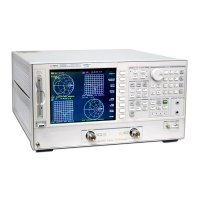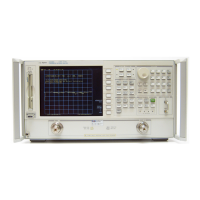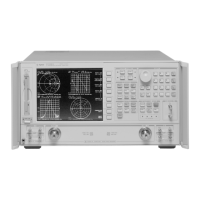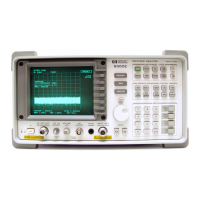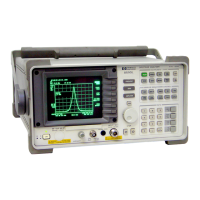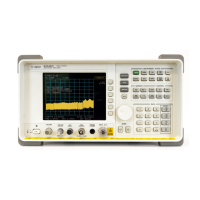Index-4
Index
four-channel display
4 Param Displays softkey, 1-18
Channel Position softkey, 1-17
customizing, 1-17
viewing, 1-14
Freelance, using, 4-21
frequency
segments, editing, 6-34
signals, deleting, 6-35
span, decreasing, 5-10
span, setting, 1-37
frequency bands
adding, 1-89
changing, 1-88
deleting, 1-90
setting, 1-87
frequency drift, 5-5
frequency list sweep of 26 points, 2-28
frequency offset mode operation, 2-10
frequency offset mode, conversion
compression
, 2-39
frequency offset mode, conversion loss,
2-13
frequency offset operation, 7-87
frequency range, 1-59, 7-89
frequency range, setting, 1-5
frequency range, setting for time domain
low pass
, 3-15
frequency response, 7-42
frequency response and isolation error
corrections
, 6-17
reflection measurements, 6-19
transmission measurements, 6-17
frequency response error corrections,
6-12
receiver calibration, 6-15
response error correction for reflection
measurements
, 6-12
response error correction for
transmission measurements
,
6-14
frequency response of calibration
standards
, 6-6
electrical offset, 6-6
fringe capacitance, 6-7
fringe capacitance, 6-7
full two-port calibration, 7-57
full two-port error correction, 6-29
G
gain, 1-64
gain compression
measuring, 1-60
using linear sweep, 1-62
gating, 3-35, 7-8
selecting gate shape, 3-36
setting the gate, 3-35
general, 8-7
generating files in a loop counter
example, 1-118
German FTZ emissions requirements,
8-8
gosub sequence command, 1-109
GPIB commands, 1-124
GPIB operation
address menu, 7-80
GPIB STATUS indicators, 7-80
local key, 7-79
pass control mode, 7-80
system controller mode, 7-80
talker/listener mode, 7-80
using the parallel port, 7-81
GPIO mode, 1-110, 7-81
graphic files
saving measurement results as, 4-44
grids
moving marker information off the
grids
, 1-26
group delay, 1-47
group delay format, 7-27
group delay measurements, 2-34
group delay principles, 7-32
H
harmonic measurements
additional, 1-57
making, 1-56
harmonic operation, 7-88
accuracy and input power, 1-59, 7-89
coupling power between channels 1
and 2
, 1-59, 7-89
dual-channel operation, 1-58, 7-88
frequency range, 1-59, 7-89
single-channel operation, 1-58, 7-88
test setup, typical, 7-88
understanding, 1-58
harmonics, measuring, 1-55
making harmonic measurements, 1-56
high dynamic range
measurement, 2-23
swept RF/IF conversion loss, 2-20
high dynamic range measurement,
2-23
high dynamic range swept RF/IF
conversion loss
measurement parameters for IF range,
2-20
power meter calibration over IF range,
2-20
power meter calibration over RF range,
2-23
receiver calibration over IF range, 2-22
RF frequency range, 2-22
high power
configuration one, 1-67
configuration three, 1-70
configuration two, 1-69
measurements, 1-66
horizontal axis, 3-13, 3-14, 3-16, 3-20,
3-23
how RF and IF are defined, 2-7
HPGL
compatible printer, 4-19
initialization sequence, sending to the
printer
, 4-24
initialization sequence, storing, 4-23
HPGL compatible printer, 4-23
HPGL/2 compatible printer, 4-9
I
IF bandwidth reduction, 7-37
IF bandwidth, setting segment, 7-19
IF delay, detecting, 5-10
IF detection, 7-7
IF range
measurement parameters, 2-20
power meter calibration, 2-20
receiver calibration, 2-22
IF, defining, 2-7
imaginary format, 7-32
improving measurement results, 5-7
decreasing the sweep rate, 5-8
decreasing time delay, 5-8
improving raw source match and load
match for TRL*/LRM* calibration
,
7-72
increase sweep speed
using fast 2-port calibration, 5-12
increasing dynamic range, 5-14
increasing test port input power, 5-14
reducing receiver crosstalk, 5-14
reducing the receiver noise floor, 5-14
increasing measurement accuracy, 5-4
connector repeatability, 5-4
frequency drift, 5-5
interconnecting cables, 5-4
performance verification, 5-5
reference plane and port extensions,
5-5
temperature drift, 5-5
increasing sweep speed, 5-9
activating chop sweep mode, 5-12
decreasing the frequency span, 5-10
reducing the averaging factor, 5-11
reducing the number of measurement
points
, 5-11
setting the auto sweep time mode,
5-11
setting the sweep type, 5-11
using external calibration, 5-12
using swept list mode, 5-9
